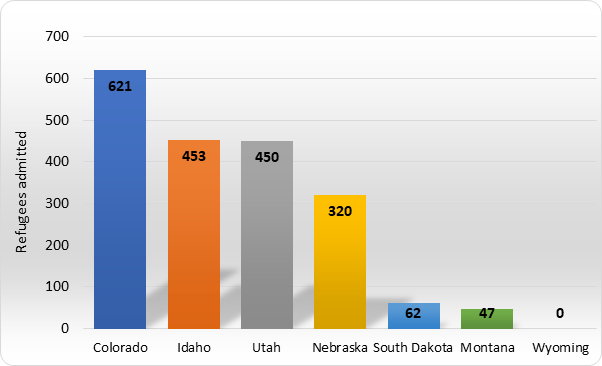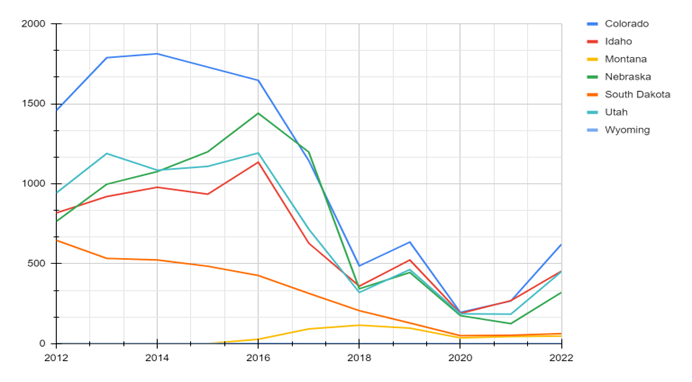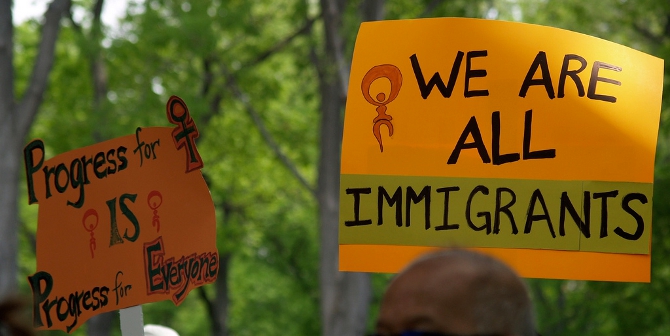Wyoming is the only US state that does not have a program to resettle refugees. To unpack why this might be the case, Shyam K. Sriram, Giuliano Espino, Ida Segmüller, Bree Kruszka, and Leah Rozbicki look at the history of the US Refugee Resettlement program and efforts in Wyoming to make it a refugee-accepting state. They write that cultural and demographic factors in the Equality State may have contributed to the lack of political will to accept refugees.
One of the most curious political situations in the United States is the answer to a trivia question: what is the only state without a refugee resettlement program? Wyoming. Why do 49 states resettle refugees while one continues to hold out? If this does not seem odd, then consider that similar conservative and rural states are still resettling refugees and helping them thrive. Wyoming, meanwhile, holds the dubious distinction of being the only state in the union to never formally accept or resettle a refugee. Churches in the state even recently banded together to help some of those evacuees from Afghanistan find a peaceful new home … just not in Wyoming.
The hypocritical nature of resettlement in the United States has been well documented, particularly recently with an arms-wide-open acceptance of Ukrainian refugees, but an infamously hostile reaction to Syrians between 2015 and 2017. And then how can we explain the response by conservative states like Utah and Montana to the recent evacuees from Afghanistan who served with the US military? Why is this group of Muslim evacuees not a threat to “American values,” but Syrians were seen as hazardous only a few years ago?
Traditionally, the rural-urban divide is the demographic variable commonly cited to explain immigration policy outcomes. This divide was popularized with Nate Silver’s “Whole Foods versus Cracker Barrel” phenomenon followed by now-Senator J.D. Vance’s bestselling book turned Netflix drama Hillbilly Elegy (2016). The divide reached scholarly prominence with Professor Kathryn Cramer’s work on rural resentment. She argues that rural residents feel ignored by state governments that tend to favor urban and suburban residents (she finds mixed empirical evidence in support of this claim). Rural consciousness leads to support of politicians believed to be against urban constituencies, though not necessarily for rural ones.
US Refugee resettlement policy and the states
The United States Refugee Act of 1980 is the decisive piece of legislation that governs refugee resettlement (RR). The law established the Office of Refugee Resettlement, which is a program in the Administration of Children and Families under the Department of Health and Human Services. Implementation of the Refugee Act is largely devloved; the federal government sets the guidelines for RR, but states individually implement the program usually under the supervision of a state refugee coordinator (often a career civil service employee or gubernatorial appointee). However, states have enormous discretion in how resettlement is implemented; the framework could take the form of a state agency; private agency; or public-private partnership. Since most Americans still believe that refugee resettlement is only something carried out by private, mostly Christian-based agencies, it creates a situation of what political scientist Professor Suzanne Mettler has termed “the submerged state.”
Data from the Refugee Processing Center (2023) shows that the US accepted just over half a million refugees between 2012 and 2022. Of that number, approximately 38,796 resettled across the six states that border Wyoming: Colorado, Idaho, Montana, Nebraska, Utah, and South Dakota. While that only represents 7.6 percent of US resettlement over that decade, these numbers still show that Wyoming’s absence as a resettlement site is at odds with the politics and policies of the region. As Figure 1 shows, in 2022 alone, these states accounted for 1,953 resettled refugees.
Figure 1 – 2022 Regional Refugee Admission

Although Colorado admitted the most refugees in absolute number terms, Idaho’s smaller population has made the state continuously rank in the highest for per capita refugee admittance. These trends in state performance have remained stable over time. Refugee admissions plummeted during the Trump administration as shown by Figure 2, primarily due to the lowering of the refugee admissions ceiling below the 50,000 minimum that had been in place since the 1979 Refugee Act. The Midwest’s regional decline in refugees is consistent with refugee admissions across the country.
Figure 2 – Regional Resettlement Over Time, 2012 – 2022

There have been at least two attempts to make Wyoming a refugee-accepting state, but the legislation has repeatedly stalled. H.B. 0266, “Refugee Resettlement Plan Accountability,” received a number on January 25th, 2023, but was not introduced as a proposed bill the next day and died even before committee consideration. The bill called for the Wyoming Legislature to be the responsive body “with exclusive authority to designate a state agency to develop and administer, or supervise the administration of, any refugee resettlement plan and to designate a state coordinator to be responsible for the coordination of public and private resources for refugee resettlement.” In 2016, however, H.B. 0047, similarly titled “Refugee Resettlement Plan Accountability,” actually passed the Wyoming House of Representatives (on its third reading), but was not introduced in the Senate and died. Like its 2023 iteration, the bill called for the Wyoming Legislature, not the governor, to be the political institution responsible for administering a refugee resettlement program.
“Welcome to Wyoming” by Kent Kanouse is licensed under CC BY NC 2.0
Why has Wyoming rejected resettling refugees?
There are a few historic and economic reasons that might explain what is going on, but we also argue that it might simply have to do with political culture. Many rural states like Montana, North Dakota, and Idaho – white, homogenous, and conservative – have adopted a more welcoming narrative around immigration, seen as a net positive to the state. This is Willkommenskultur or welcoming culture, most recently associated with Germany’s admission of millions of Syrian refugees. Willkommenskultur has become a rallying cry for an open society towards immigrants particularly recently with Syrians, Ukrainians, and other groups. These states often establish sophisticated, though privatized, refugee resettlement implementation authority that seeks refugees because they are seen as providing a net positive to the economy.
By contrast, we believe Wyoming’s resistance to refugees is predicated on the idea of Ablehnungskultur or a culture of rejection. In Germany, the term describes a hostile environment for immigrants in society and politics, but we apply it for the first time to an American context. The lack of permanent immigration into Wyoming during the 20th century manifests itself in the state’s current demographics, which also adds to its Ablehnungskultur. Over 90 percent of the state claims European heritage and 98 percent of residents were born in the state. Additionally, Wyoming’s Department of Family Services (DFS) is notorious for its stringency in providing economic assistance and is the least technologically developed of any state. The DFS still works off a primarily pen and paper system, leading to a system impossible to traverse. The state continuously performs the worst in the provision for social services such as the Supplemental Nutrition Assistance Program (SNAP).
And yet, drawing on President Biden’s Sponsorship Circle program, some Ukrainians have finally made their way to Wyoming in 2023. The United for Ukraine program had accepted ten “refugees” as of January 2023, but the state still has not formally adopted a resettlement. What makes this confusing is that there is still no state refugee coordinator, no formal mechanism for accepting refugees, no national or local resettlement agencies, and no political will to make those changes according to Prof. Suzan Pritchett. As observers noted, there was political interest in accepting Afghan humanitarian evacuees into Wyoming, specifically those who served as allies with the US military. During a public forum in August 2021, Governor Mark Gordon said, “These are remarkable people that have really stood by our side, risking their lives and their families’ lives. They deserve to have compassion from us.” But this sentiment has not materialized into actual resettlement policy implementation and no asylees or evacuees from Afghanistan ever moved to Wyoming.
Please read our comments policy before commenting.
Note: This article gives the views of the author, and not the position of USAPP – American Politics and Policy, nor the London School of Economics.
Shortened URL for this post: https://bit.ly/3pvQVVs







It’s really quite simple: NO ONE WANTS TO PLACED IN WYOMING. Don’t write about what you have not lived. Most people want to see more humans than they do cows and/or fence posts, they want readily accessible resources and temperate weather. Wyoming does not have a refugee settlement program for the very simple reason that IT DOES NOT NEED ONE.